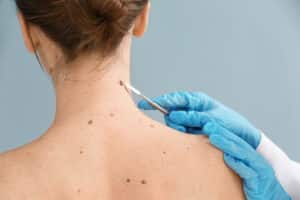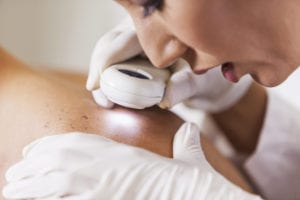Skin Cancer FAQs

Explore the American Society for Mohs Surgery’s comprehensive Skin Cancer FAQs as part of our patient resources. Here, you’ll find detailed explanations about the nature of skin cancer, its causes, signs, and much more to help you understand this disease.
What Is Skin Cancer?
Skin cancer occurs when there are mutations in the DNA of skin cells. These mutations cause the cells to grow uncontrollably and form masses of cancer cells. Unlike normal cells that have a controlled growth and death cycle, cancer cells do not die off in the usual way and can accumulate, forming tumors.
The skin is your body’s largest organ and has many essential functions, such as protecting you against heat, sunlight, injury, and infection. It also helps regulate body temperature and stores water, fat, and vitamin D. Skin cancer can disrupt these functions, depending on its severity and location.
The growth of cancerous cells in the skin can lead to several problems, including:
- Compromised skin integrity: As tumors grow, they can compromise the skin’s ability to function as a barrier against environmental damage.
- Aesthetic changes: Skin cancer can cause significant changes in appearance, which might affect areas of the skin that are visible and potentially lead to psychological impacts.
- Local tissue destruction: In more advanced cases, especially without timely treatment, skin cancer can destroy nearby tissue and may cause significant disfigurement.
- Metastasis: Particularly in the case of melanoma, skin cancer can spread (metastasize) to other parts of the body, which can affect the function of other organs and potentially be life-threatening.
What Are the Common Signs and Symptoms of Skin Cancer?

The signs and symptoms of skin cancer can vary depending on the type but commonly include:
- New growths or sores that do not heal.
- Changes in existing moles, such as size, shape, color, or texture.
- Development of new, unusual skin changes or growths.
- Patches of skin that are scaly, bleeding, or have changed color.
What Causes Skin Cancer?
Skin cancer is primarily caused by exposure to ultraviolet (UV) radiation from the sun and tanning beds, which can damage the DNA in skin cells. Other risk factors include:
- Fair skin that freckles easily and burns instead of tans.
- A family history of skin cancer.
- Exposure to toxic substances, such as arsenic.
- Living in high-altitude or sunny climates where the sun’s rays are stronger.
How Is Skin Cancer Diagnosed?
Skin cancer is diagnosed through a combination of physical skin exams and medical procedures. If your healthcare provider finds a suspicious lesion, they will:
- Closely examine your skin’s appearance.
- Take a biopsy of the lesion, where they send a small skin sample to a laboratory to determine if cancer cells are present.
What Are the Different Types of Skin Cancer?
Basal Cell Carcinoma
Basal cell carcinoma is the most common type of skin cancer and the most frequently occurring of all cancers. Eight out of every 10 skin cancers are basal cell carcinomas, making this form of skin cancer far and away the most common.
Squamous Cell Carcinoma
Squamous cell carcinoma is the second most common form of skin cancer. It forms in the squamous cells that make up the middle and outer layer of the skin. Most squamous cell carcinomas result from prolonged exposure to ultraviolet radiation from the sun or tanning beds or lamps.
Melanoma
Melanoma is one of the most dangerous forms of skin cancer that can spread at any time to form malignant tumors in other parts of the body. Melanoma may be caused by ultraviolet damage or may be due to genetic factors in some individuals. Possible warning signs for melanoma are known as the ABCDEF’s and are asymmetry, irregular border, color differences, diameter wider than a pencil eraser (6 mm), and evolution or changes in the mole, and family history. It is important to do self-exams and become familiar with the moles on your body. If any changes are noted, it is important to have the lesions looked at by a dermatologist.
Merkel Cell Carcinoma
Merkel cell carcinoma is a rare and aggressive form of skin cancer which has a high risk of recurring and spreading to other parts of the body. Risk factors are sun damaged skin in fair-skinned people over 50 years old, but it can occur in people with darker skin tones. These tumors tend to grow rapidly and can be reddish, purple, or skin colored. As with melanoma, early detection is important for survival.
Actinic Keratosis
Otherwise known as a “precancer,” an actinic keratosis is usually a scaly spot that is found on sun-damaged skin. Actinic keratoses are usually non-tender, may be pink or red and rough, resembling sandpaper. They occur most frequently on the face, scalp, neck, and forearms. Actinic keratoses are considered precursors to squamous cell carcinoma, although most do not progress past the precancer stage
Atypical Fibroxanthoma
An atypical fibroxanthoma is a skin tumor that most commonly occurs on the head and neck of elderly people with sun damaged skin or in people who have received radiation therapy. The lesion can be pink, skin colored, or reddish with or without crusting. These can behave rather indolently or they can be aggressive and spread through the local tissue.
Dermatofibrosarcoma Protuberans
Dermatofibroma sarcoma protuberans is a rare tumor that arises from cells in the dermis and has an unknown cause. It usually presents as a painless, thickened bump in the skin which grows slowly over time. They are red and brown in color and tend to recur after surgical excision unless the margins are definitively cleared. These tumors can have a very extensive deep component and require large margins to clear adequately.
Have Additional Questions? Contact Us Online
What Are the Treatment Options for Skin Cancer?
Treatment options for skin cancer depend on the type, size, location, and stage of the cancer, but commonly include:
- Surgical removal: Excising the tumor and some surrounding tissue.
- Radiation therapy: Using high-energy rays to target and kill cancer cells.
- Chemotherapy: Applying topical medications to kill cancer cells for superficial cancers.
- Targeted therapy: Using drugs designed to target specific aspects of cancer cells to stop their growth.
How Often Should I Check My Skin for Signs of Skin Cancer?
We recommend performing regular self-exams to check for new skin growths or changes in existing moles, freckles, or spots. As a guideline, a monthly self-examination of the skin can be effective in noticing changes early.
If you’re at higher risk due to a family history of skin cancer, fair skin, or a previous diagnosis, you may want to check yourself more frequently.
You should also schedule annual skin exams with a healthcare professional, especially for individuals with elevated risk.
Can Skin Cancer Be Cured?
The curability of skin cancer largely depends on its type and the stage at which it is diagnosed. Early detection significantly improves the chances of successful treatment.
For example, basal cell carcinoma and squamous cell carcinoma have a high cure rate when treated early. Melanoma can also be effectively treated if caught early, but it can be more challenging to treat at advanced stages. Regular screenings and prompt treatment following detection are critical to help improve outcomes.
What Are Some Skin Cancer Prevention Strategies?

Taking sun protective measures is the best way to prevent sun damage and the possibility of skin cancers in the future. We recommend:
- Wearing at least an SPF 30 sunblock daily, however even higher numbers of SPF are ideal
- Reapplying sunblock every 2 hours if in the sun, swimming, or exercising
- Seeking shade during the peak hours of 10 am to 4 pm
- Avoiding intentional tanning and tanning beds
- Using sunblock with the ingredients zinc oxide and/or titanium dioxide
- Having your skin examined at least once a year by a dermatologist.
*Information was supplemented by the Skin Cancer Foundation at skincancer.org and Dermnet New Zealand
Contact the American Society for Mohs Surgery
Skin cancer education and skin cancer surgery training are offered by the American Society for Mohs Surgery. If you are interested in learning more, contact us today by calling (785) 783-2070. You can also click the button below to send us a contact form, and our staff will get back to you at the earliest.


